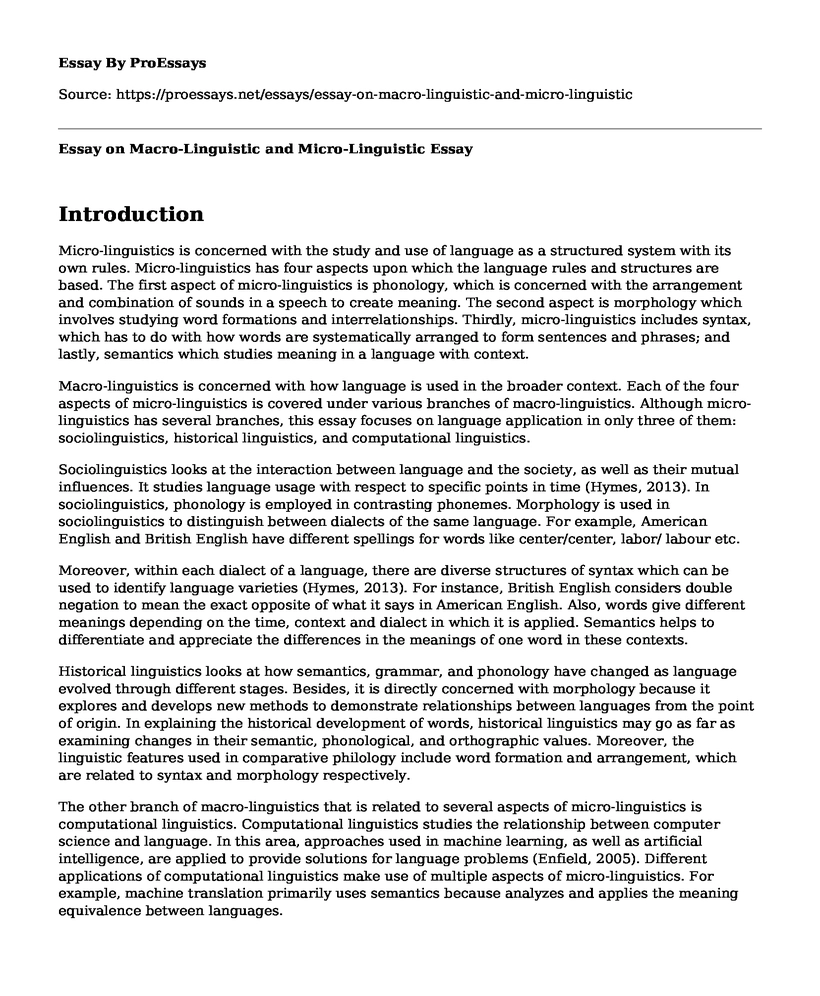Introduction
Micro-linguistics is concerned with the study and use of language as a structured system with its own rules. Micro-linguistics has four aspects upon which the language rules and structures are based. The first aspect of micro-linguistics is phonology, which is concerned with the arrangement and combination of sounds in a speech to create meaning. The second aspect is morphology which involves studying word formations and interrelationships. Thirdly, micro-linguistics includes syntax, which has to do with how words are systematically arranged to form sentences and phrases; and lastly, semantics which studies meaning in a language with context.
Macro-linguistics is concerned with how language is used in the broader context. Each of the four aspects of micro-linguistics is covered under various branches of macro-linguistics. Although micro-linguistics has several branches, this essay focuses on language application in only three of them: sociolinguistics, historical linguistics, and computational linguistics.
Sociolinguistics looks at the interaction between language and the society, as well as their mutual influences. It studies language usage with respect to specific points in time (Hymes, 2013). In sociolinguistics, phonology is employed in contrasting phonemes. Morphology is used in sociolinguistics to distinguish between dialects of the same language. For example, American English and British English have different spellings for words like center/center, labor/ labour etc.
Moreover, within each dialect of a language, there are diverse structures of syntax which can be used to identify language varieties (Hymes, 2013). For instance, British English considers double negation to mean the exact opposite of what it says in American English. Also, words give different meanings depending on the time, context and dialect in which it is applied. Semantics helps to differentiate and appreciate the differences in the meanings of one word in these contexts.
Historical linguistics looks at how semantics, grammar, and phonology have changed as language evolved through different stages. Besides, it is directly concerned with morphology because it explores and develops new methods to demonstrate relationships between languages from the point of origin. In explaining the historical development of words, historical linguistics may go as far as examining changes in their semantic, phonological, and orthographic values. Moreover, the linguistic features used in comparative philology include word formation and arrangement, which are related to syntax and morphology respectively.
The other branch of macro-linguistics that is related to several aspects of micro-linguistics is computational linguistics. Computational linguistics studies the relationship between computer science and language. In this area, approaches used in machine learning, as well as artificial intelligence, are applied to provide solutions for language problems (Enfield, 2005). Different applications of computational linguistics make use of multiple aspects of micro-linguistics. For example, machine translation primarily uses semantics because analyzes and applies the meaning equivalence between languages.
At the same time, machine translation considers syntax differences because the arrangement of words in a sentence, clause or phrase differs from one language to another. For example, in French, descriptive adjectives come after nouns while in English, they precede the noun, as in stylo rouge for red pen. In this phrase, stylo is the word for pen and rouge is red.
The other interesting application of computational linguistics is speech recognition which relies on pronunciation to determine spelling and meanings of words. It is the technology behind all voice-based services, and it uses phonology to differentiate between millions of words in each language. After recognizing speech, the technology types them automatically on the user's device. Therefore, it also uses morphology to find the right spellings.
References
Enfield, N. J. (2005). Micro-and macro-dimensions in linguistic systems. Trends In Linguistics Studies and Monographs, 161, 313.
Hymes, D. (2013). Foundations in sociolinguistics: An ethnographic approach. Routledge.
Cite this page
Essay on Macro-Linguistic and Micro-Linguistic. (2022, May 16). Retrieved from https://proessays.net/essays/essay-on-macro-linguistic-and-micro-linguistic
If you are the original author of this essay and no longer wish to have it published on the ProEssays website, please click below to request its removal:
- Learning English as a Foreign Language in Saudi Arabia
- Evaluating Truth and Validity Exercises Paper Example
- The Effect of Teaching Methods in Learning English Using the Qualitative Approach
- Comparing and Contrasting Life in College Verses Life in High School Essay
- Questions and Answers on Gun Violence at Harper High School Paper Example
- Essay Sample on Babies' Attachment Patterns
- My Dream Vacation - Free Essay Sample







